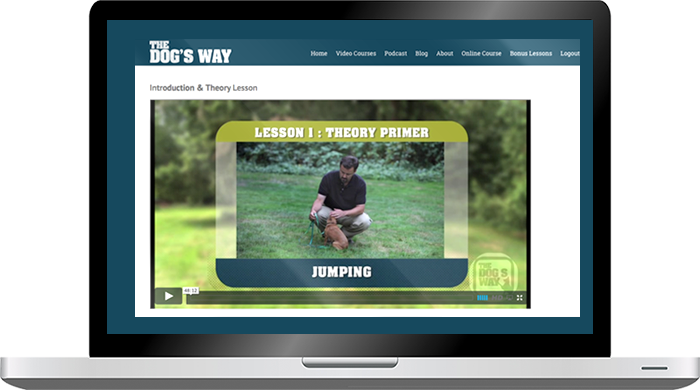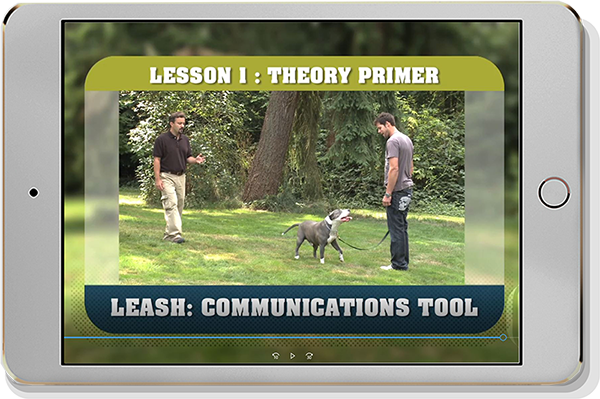The Dog’s Way Online Video Training Course for
Dog’s Over 7 Months
You will get
19 video lessons
Downloadable and Printable Reminder Cards
Downloadable and Printable Workbook to Augment Each Video Lesson
Three years of access to the course online.
30 Day Money back Guarantee!
What the course is
What the course isn’t
Some people have sent in a lot of questions asking what the course is all about. In response, I did a couple of little videos telling you what’s is in the course and (maybe more importantly) what’s not in the course. Hope these help.
Also please note: the DVD Course mentioned in the above videos is no longer available. The course is completely online at this time.
Frequently asked questions about the course and the style of training
It’s important for me that the course is a fit for you. Here are some questions that folks have emailed me that represent the bulk of questions that I get (and my responses to them). If your question isn’t answered here, feel free to email me.
- Walking on a loose leash
- Sitting
- Staying
- Walking next to you in a controlled way on a shortened leash
- Leaving certain things alone on command (leave it)
- Leaving other things alone ‘permanently’ with no command required
- Coming when called
- Staying in a down for 10 minutes and longer
- Understanding temporary boundaries (stopping them from entering a room on command)
- Understanding permanent boundaries (for example: never bolting out the front door again)
- Staying quiet
- Settling down
- Meeting people
- Meeting dogs
There are other specific scenarios and lessons that are covered in mini-lessons in the “student section” on the log-in part of the website. For example, there are mini-lessons on things like:
- Getting your dog comfortable with bathing
- Learning to trim your dog’s nails without having to wrestle them to the ground
- Teaching your dog to accept brushing calmly
The Online Video Course Includes:
- Three years of access to the online course
- 12 step-by-step video lessons
- 15 downloadable and printable reminder cards to take with you on your walks and homework sessions as a reminder of key “Do’s and Don’ts”
- Bonus and problem-solving video lessons on the “student’s section” of the website
- Your downloadable and printable workbook to follow along with each lesson to make sure you’re getting all the info in each lesson.
The downloadable workbook includes
- Specific homework assignments
- A quick quiz in your downloadable and printable workbook on each section to solidify your theory learning
- Detailed competency self-assessments to track your progress
In short – no. It would probably be a better “sales pitch” to simply say, “hey, use this video course for every dog situation no matter what”. However, it’s sort of a pet peeve of mine (no pun intended) when someone watches a TV show, or reads a book (or watches a video course) and tries to rehabilitate a dog dealing with aggression issues. It’s not that much of the content and exercises aren’t potentially helpful and similar to how we go about working with clients in person in these situations. It’s really that some aggression issues are potentially very dangerous, and it’s my recommendation that anyone that has a dog that is exhibiting aggression should consult with a trained professional so that a behaviorist or trainer can assess your dog and determine what level of risk is associated with having people or other animals around a dog dealing with these issues.
There are lots of “positive-only” trainers that label people that don’t train in exactly their method as “unscientific”. Often, it’s a form of public relations persuasion against trainers that they simply disagree with. You might also hear versions of this criticism towards balanced trainers (who use fair and consistent positive and negative feedback with dogs), as being “old fashioned”. These critiques are designed to depict “positive only” trainers as; good, smart, humane, scientific, and new. At the same time, they try to depict balanced trainers as: bad, dumb, inhumane, unscientific and old fashioned (and I almost forgot – abusive). It’s a clever way to frame the issue, to be sure. The only problem is that it’s not entirely accurate or factual.
I heard a lot of this sort of discussion early on in my career because I was originally trained in a “purely positive” method of dog training. I heard that there is only one way to train a dog, “Our way or the wrong way!” I noticed that, while the purely positive method worked for a very small number of dogs, most dogs just couldn’t become functional in real life situations with a purely positive method of training. When I began questioning some of the precepts of the “purely positive” method, I was met with all the fervor of someone pondering the idea that that maybe the earth actually revolved around the sun circa 1500’s Europe. Fortunately, for me, I was also volunteering in shelters helping to exercise and socialize dogs after hours. I noticed during social interactions among dogs that they used both positive and negative feedback with each other all the time. That’s when the light bulb went off for me. The strange thought in my head was, “I guess dogs never read the purely positive dog communications book … because that’s not how they do it?”
I think the implication when some trainers call others unscientific, or uneducated or abusive is that those “bad” trainers somehow don’t understand the benefits of “positive reinforcement”. I don’t know any trainers that reject the use of positive reinforcement in training. Balanced trainers use both positive and negative feedback in a full spectrum of communication with an eye on getting the functional result in everyday life.
To be clear, I’m a fan of people living their lives the way they want to live them, and If people want to train in a “purely positive” method, a “purely psychic” method or some other version of dog training, and they seem to get the results they’re looking for, I think that’s OK. All I can do is tell you about the conclusions I came to and why I ended up there.
So, maybe I can respond to the “unscientific” charge this way. Let’s do a quick quiz. Which type of trainer do you think is more unscientific?
As I’m sure many of you know, the scientific method is relatively straight forward and has been around for a few centuries now. It’s as follows:
- Have a theory about something
- Test that theory
- If that theory gets the result that you thought it would get, then great – Eureka!
- If that theory, when tested, does not get the result you predicted, then go back up to step number one and start the process again by revising your theory because you’ve now proved it lacking.
So, knowing that, which type of dog trainer is more “scientific” and which is more “unscientific”?
Dog Trainer A
A trainer that has a definite hardened theoretical ideology, and when faced with a lack of results, when trying to put those theories into practice, doesn’t re-examine their theories and assumptions, but instead expends a lot of energy casting aspersions at people who don’t rigidly follow their ideology.
Or;
Dog Trainer B
A trainer, who believes it’s OK for different people to train dogs differently, that has an open framework and uses many training techniques at their disposal. They run through the above mentioned “scientific method” testing process constantly with an eye on adjusting techniques and strategies until results are achieved with each dog.
I’ll let you decide which trainer seems more “scientific”. 😊

The Dog’s Way Video Training Course
A Different Approach to Dog Training Videos
When I started the preparation process for making the video course, I watched tons of dog training videos to see what was out there (yes, there are just about literally “tons” of dog training videos out there). I noticed that almost all of them had a few things that I didn’t like.

